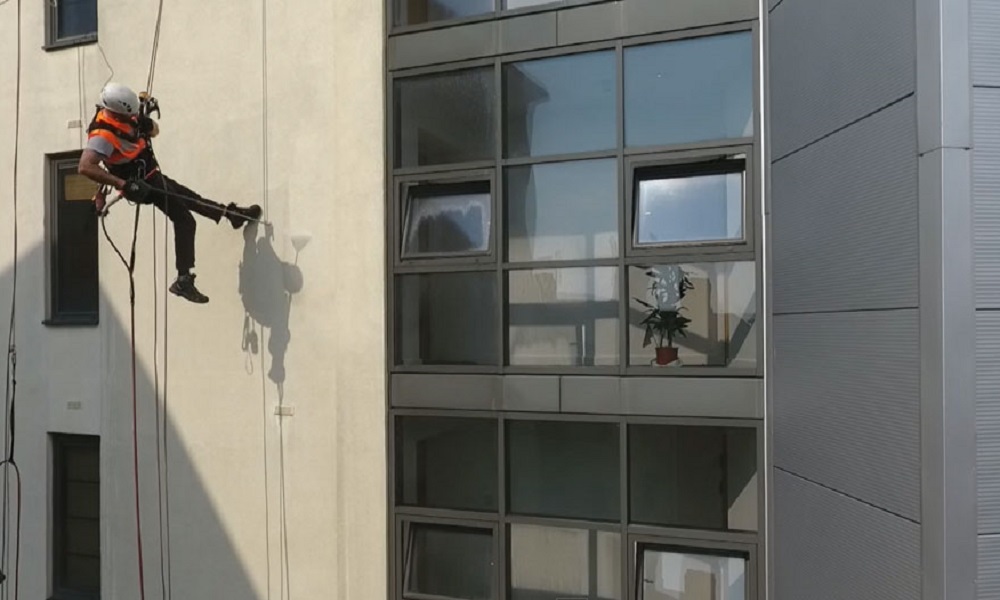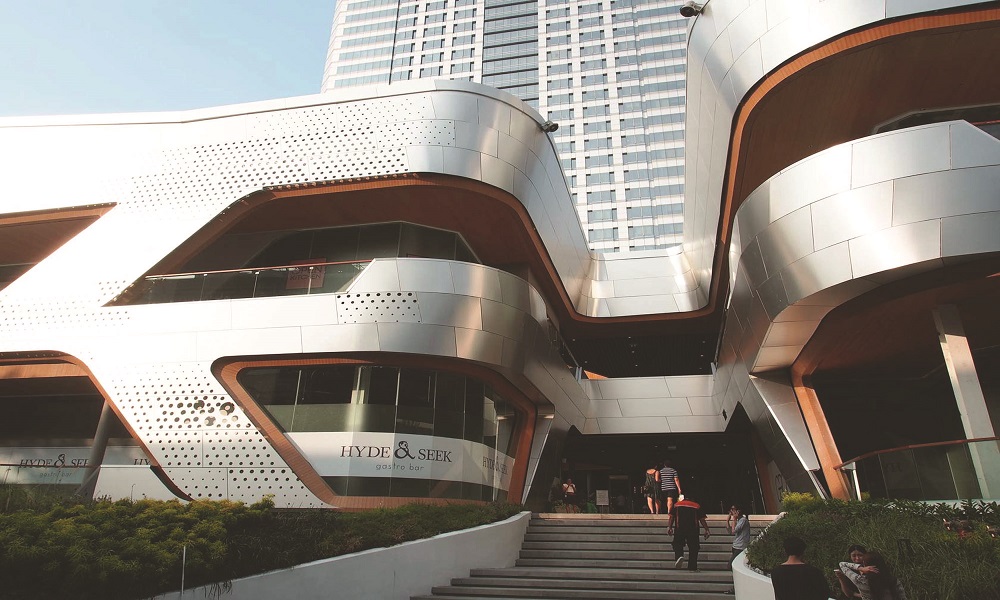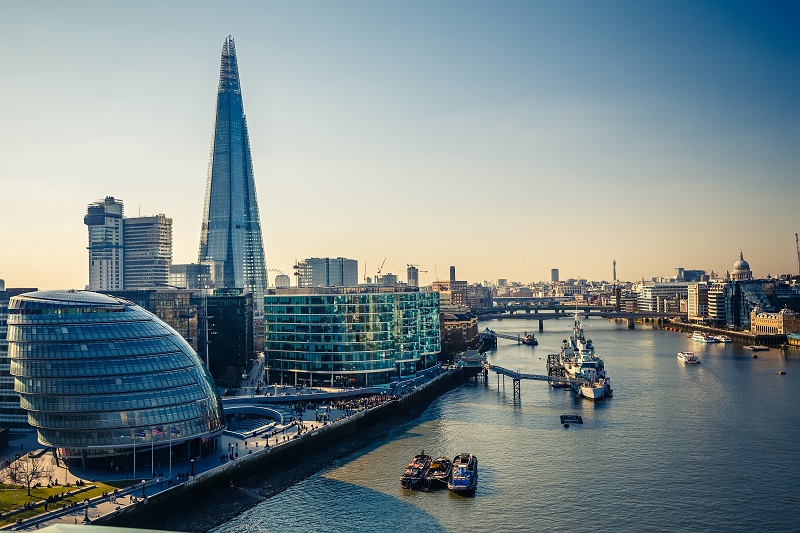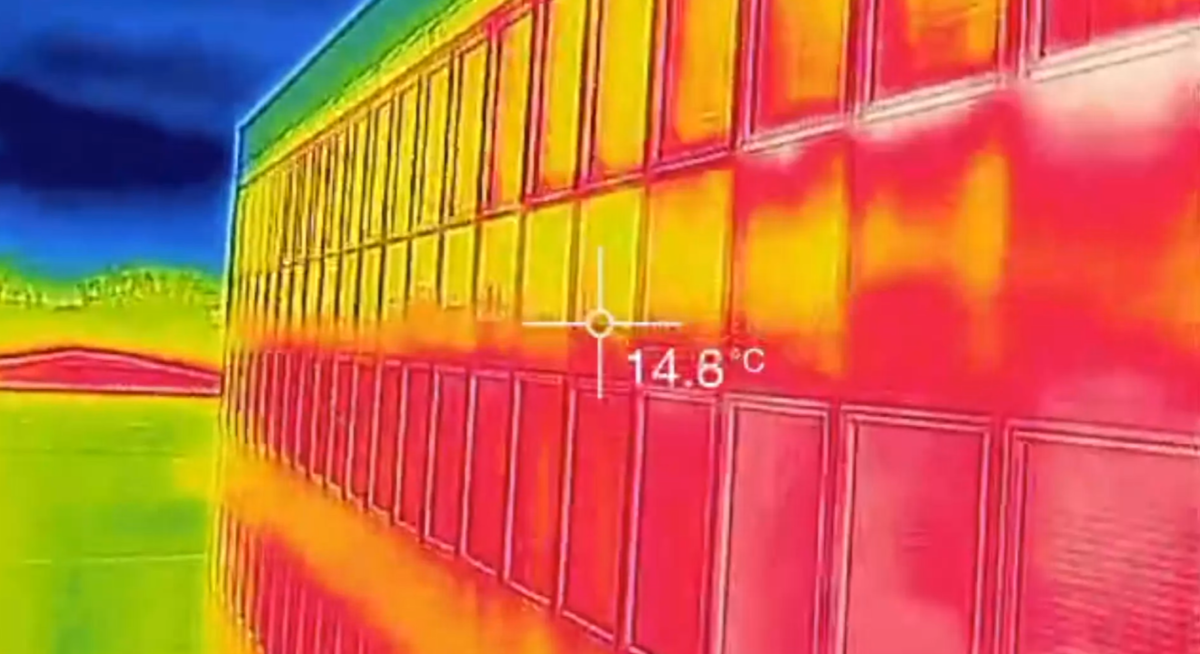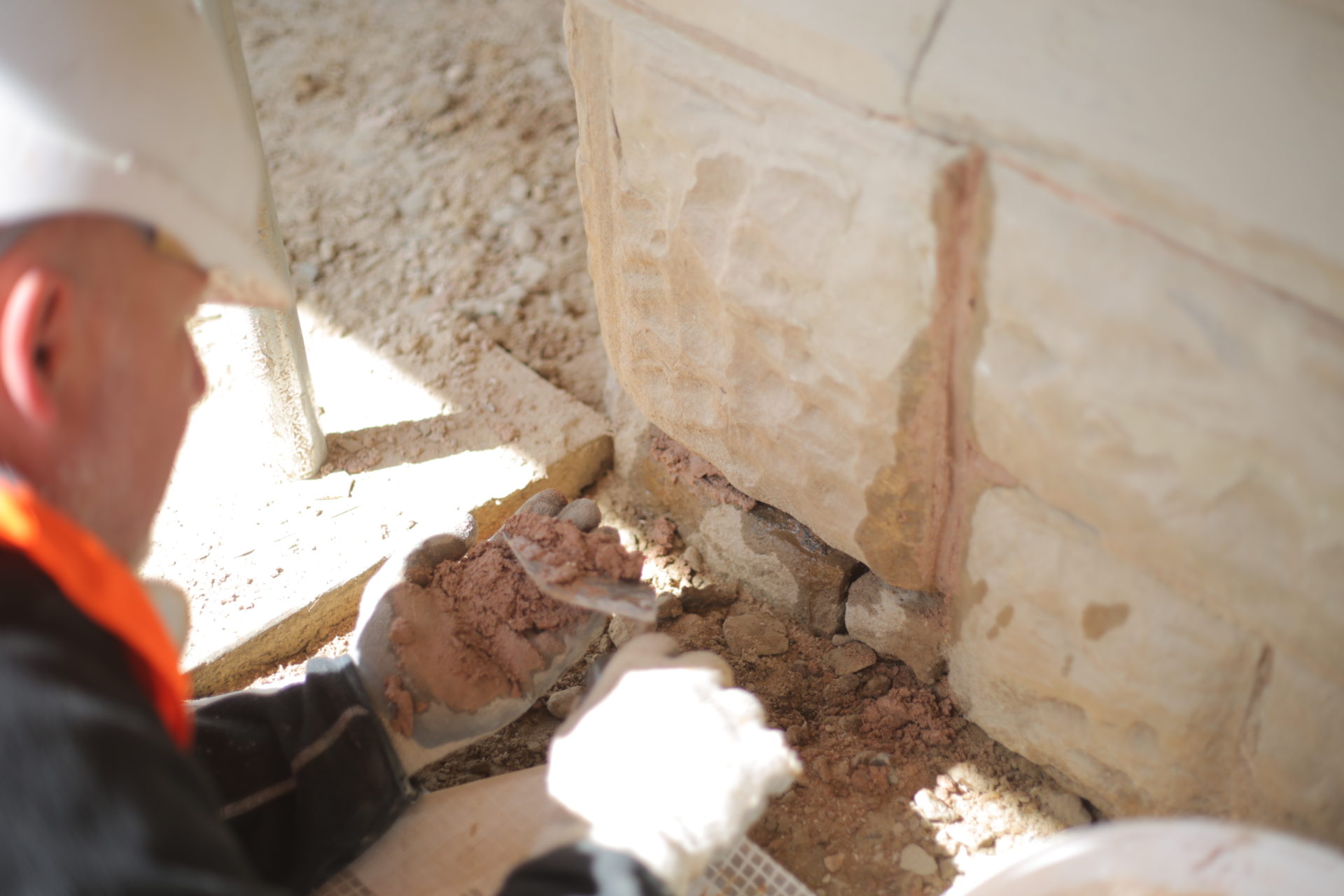In Europe, building cleaning is an essential part of the planned maintenance schedules, with buildings generally cleaned every 2 years. It is a cost that property owners prioritise to protect their investments. Sadly, this is not the case here in the UK and where buildings are left for 10 to 20 years before any cleaning is considered. The main reason for this is that traditional construction materials such as brick and stone tend to age very well without cleaning and changes to the colour on these materials is usually seen as a positive improvement to their appearance. The same cannot be said for rendered facade systems, which are designed to look a consistent colour throughout.
When these renders start to fade or become dirty from organic growth or traffic pollutants, they will quickly begin to look tired and poorly maintained. Though lime renders have been around for years, the development of newer render systems for use on larger buildings has only really started to gain momentum since the mid-90s. This relatively cost-effective and quick form of façade construction on many buildings is now starting to show signs of discolouration as effects from both organic growth and atmospheric pollution leave their mark. As treating dirty render is a relatively new problem, there does seem to be a lack of knowledge as to how to effectively clean it, which is proving a real problem for building owners.
What are the key issues when cleaning render?
1. Soiling Patterns – Render by its very nature, is designed to be breathable so that moisture can evaporate from the building. As a result, the tiny capillaries in the render, which the moisture escapes from provides an ideal place to harbour organisms. This, along with the textured surface, means that render is an excellent host for organic growth and development.
2. Cleaning Method – Render varies in colour, texture and composition, so choosing the correct cleaning method for the surface can be difficult. There is also the added complication of the length of time the building has been left without cleaning, as in some instances the render may have become permanently stained. Sanitisation, steam cleaning, and sensitively repeating the correct methods provide the most effective and sustainable render cleaning and restoration methods. Each building, profile and soiling severity will alter and influence the methods, dwell times and repetition required to achieve the desired result.
3. Access – Many of the render systems purport to be self-cleaning, so often little consideration is given during the construction phase as to how the façade will be regularly maintained. This gives building owners a real problem as once built and the scaffolding is removed, it can be very difficult to access the façade for effective cleaning or maintenance to clean cost effectively.
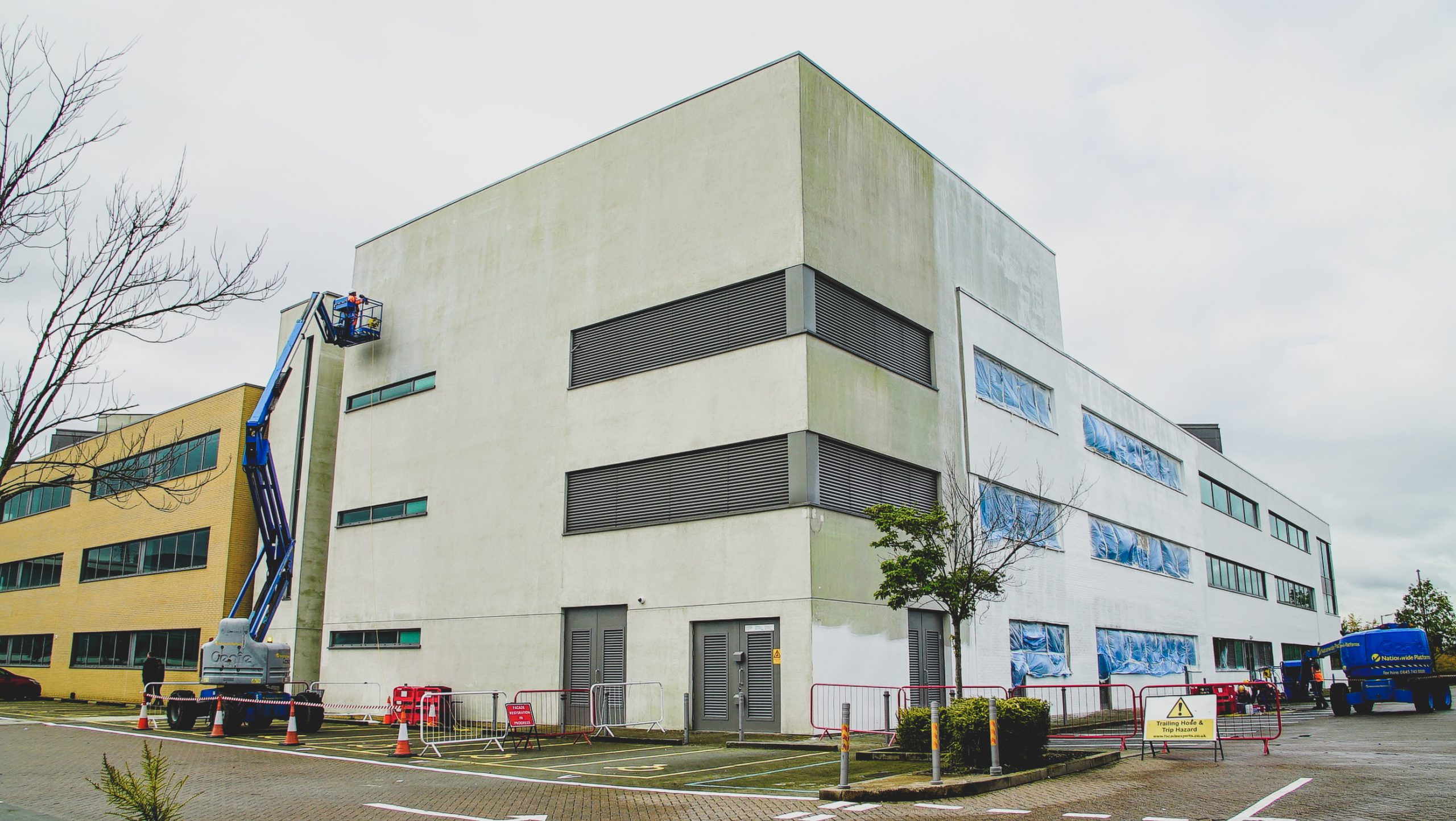
Render Façade Soiling Types
Predominantly, there are three main ways that render becomes dirty; organic, atmospheric and man-made. We discuss these three elements in more detail below:
Organic – Algae and moss thrive best in damp, dark environments so most of the worst organic growth on render will tend to be visible on the darker north and east elevations of a building. Organic growth can occur in many shapes, sizes and colours but is most commonly seen as a green hue across large sections of render. There are often a number of key geographical, environmental and maintenance factors that will increase the likelihood of growth.
Geographically – rendered buildings close in proximity to water such as rivers lakes and seas tend to have a greater build-up of organic growth due to the wetter conditions.
Environmentally – rendered buildings next to large trees and foliage will be more prone to organic growth as spores can transfer easily from the trees.
Maintenance – on rendered buildings this is important as where gutters and downpipes are poorly maintained, drips can occur, leading to increased moisture on the façade and subsequent organic growth.
Atmospheric – Rendered buildings situated close to roads and located in busy towns and cities are often more prone to developing general dirt and grime build up on the render. Although the development over time may not be as noticeable as organic growth, the render will begin to look faded and take on a dull grey appearance particularly on lighter render colours.
It is important to remove this type of build-up as the pollutants sitting on the surface can act as a poultice attracting airborne particles at a greater rate and eventually causing staining to the render as the particles work their way into the pores of the render.
Man-made – This type of staining tends to be random in development but is often the most damaging to the building aesthetically if not quickly removed. The staining can occur from just about anything spilt onto or thrown at the rendered façade, and if not cleaned away quickly can cause permanent staining. Often this type of staining will be seen under window frames, where drinks have been spilt out of windows, causing marking on the render. When left to dwell on the building, atmospheric dirt is attracted to the sticky stains, exacerbating the problem visually. Before a decision is made to clean the render, it is important to survey the façade to understand the types of staining that is present. This is because it is likely that a different cleaning approach will be required to remove organic growth over, say atmospheric or man-made marks and stains.
Various techniques can be selected to clean render, so choosing the correct methodology will often come down to test sampling and using the knowledge and experience of the contractor chosen. Decisions on methodology should not be limited to the cleaning result alone but should include consideration to safety, the environment and cost benefits of the selected approach.
We have established the key types of staining that affect rendered façades, now, it is important to highlight the cleaning methodologies that are available to clean them. With all approaches, test sampling before starting a project is key and should always be carried out before work commences. The test sample should be representative of the staining on the building and should attempt to tackle the worst areas.
Render Cleaning Methods
Different renders and staining should be treated individually, and processes should be selected to suit the staining and the site limitations. Different render types will also be fixed differently to the building, and this should also be considered when reviewing the cleaning processes.
Abrasive or high-pressure cleaning – This is often suited for cleaning general grime and organic matter and is quick and can deliver fast results. Too much pressure, however can often cause damage to the surface and may cause a loss of substrate when cleaning. This may be visible through cleaning marks on the render, which tend to affect the uniformed appearance of the rendered façade. Mineral-based renders are very susceptible to high-pressure cleaning damage and high rates of organic regrowth.
Over-cleaning with high-pressure cleaning can also cause the top protective coating of the render to be lost, thus exposing the substrate beneath. The surface then becomes exposed to the elements and is prone to the effects of weathering with organic matter finding it easy to find a home on the less protected surface.
Finally high high-pressure cleaning may not be suited to the environment due to the high levels of debris produced by the cleaning action. Without testing and understanding the substrate, it is difficult to fully understand the likely impacts of cleaning using this method. In areas of high footfall fall this approach may not be viable.
Sanitisation – An excellent render cleaning method, it’s cost-effective, sensitive and highly effective, especially for areas of widespread organic growth. Rather than simply cleaning, a sanitisation process works much deeper into the rendered façade structure, killing and breaking down the render spores. This method, when combined with steam cleaning, is highly effective. The use of specialist sanitising agents can be an excellent way to treat and clean render. The unique anti-bacterial products are left to dwell on the façade and soak deep into the substrate, killing off deep-rooted organic matter. The product is typically left to dwell for 48 hours before being rinsed off with light steam pressure. The product achieves an effective 99.9% germ kill and eliminates the requirements for high-pressure cleaning.
Low-pressure steam cleaning – While the use of steam is often slower, it is capable of delivering very impressive results without damaging the render. The use of ‘superheated water’ as a cleaning agent is very effective, and the high temperature has the added benefit of killing organic matter such as algae spores, so it acts to inhibit regrowth. A light liquid spray is delivered at steam creating temperatures through a specifically designed cleaning nozzle. As the steam created requires less water, the pressures used are much lower, giving the result of a very sensitive clean with minimal debris.
Steam cleaning should ideally be undertaken in two main stages; the first involves spraying the rendered façade with a low-pressure steam and water solution to soften any accumulated dirt. This process acts to provide a clearer indication of the condition of the façade, highlighting any significant staining on the render. In some instances, this process alone can deliver great results if the building is cleaned on a regular basis.
The second cleaning phase, often on buildings with heavier accumulations of pollution, will allow the cleaning operative to adapt and adjust the steam-cleaning processes for a more detailed and sensitive clean. To remove deeper soiling e.g. physical accumulation of atmospheric pollution, organic growth and superficial surface staining, the process can be combined with a pH-neutral cleaning agent. This is then manually agitated into the render using a soft brushing process to help break down the surface staining and organic growth. The application of products should be undertaken in a controlled manner and by an experienced operative who will also ensure the products are fully rinsed from the façade on completion.
It is essential with this type of cleaning that before work begins, any defects in the façade are highlighted, and seals, cracks, junctions with window frames and any other potential water penetration points are carefully sealed to minimise the intake of water internally.
Chemical cleaning – Chemical methods are best and most effectively used to sensitively break down, soften or dissolve the soiling on the rendered façade without the need for high-pressure cleaning requirements. When used in a controlled manner, these cleaning agents help deliver excellent results, but the content of the solutions must be reviewed before use to ensure that they do not react with the render coatings themselves.
Small onsite cleaning trials will establish the most appropriate cleaning agent to deliver the results that are required. Chemical cleaning can be highly versatile and adaptable to the specific requirements of the individual building. Careful analysis of render conditions and on-site trials should be made before use, as incorrect selection may leave the rendered façade permanently stained or physically damaged.
Protective coatings – Once clean, your render can be re-coated and protected with long-term, permeable, hard wearing and protective coatings. These come with varying guarantees and help to protect the building against the staining and soling that has previously occurred. This is only effective on the rendered façade once the cleaning process has been completed, but when combined with cleaning can help to add a greater return on investment.
If you’re looking for render cleaning, repair, or removal solutions, speak to one of our experts today. We can supply specialist access solutions to test, inspect, repair, and maintain any building or structure, even those with the most challenging access points.

